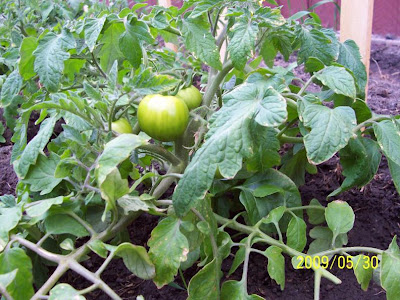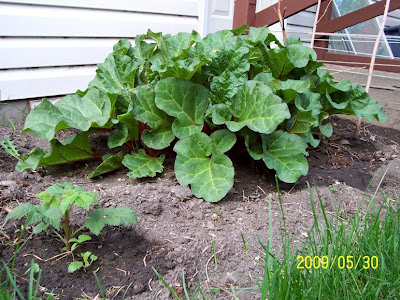With a change of winds in the forecast (north to south winds) and the tomatoes becoming seriously root-bound, a risk was taken with transplantation to the outside world (May 21). They wilted for the first day or so, likely complaining primarily about the drastic drop in soil temperature they experienced (i.e. 20 °C to maybe 5 to 10 °C). A cold frame was built consisting of the old windows used in the
Cold Frame #1 experiment to help warm up the soil and protect them at night. In hindsight the cold frame should have been constructed a few weeks in advance to pre-warm the soil (note to self for next year).

Note Kale & Brussels Sprouts on the left (transplant from generous neighbour) & Lovage in the center (in above photo). Peas and Swiss Chard are just starting to break the surface (can't see in this photo).
 Part of the experiment was to test the cold frame in frost conditions with a sensitive plant like tomatoes. Frost was predicted that night, so last minute scrambling resulted in blankets and tarps over the windows and a 60W bulb placed inside to provide a heat source (a method used successfully by my aunt). I had plans to put a fan inside as well to circulate the heat, but due to limitations with the extension cord and time, only the light was used in the end.
Part of the experiment was to test the cold frame in frost conditions with a sensitive plant like tomatoes. Frost was predicted that night, so last minute scrambling resulted in blankets and tarps over the windows and a 60W bulb placed inside to provide a heat source (a method used successfully by my aunt). I had plans to put a fan inside as well to circulate the heat, but due to limitations with the extension cord and time, only the light was used in the end.


The tomatoes survived the night with a frost of about -1.4 °C according to
Environment Canada measurement at the Calgary International Airport. The Middle Earth Garden is about the same elevation as the airport and within 4km or so. So the airport temperatures are likely a good approximation for now.
A high-low recording thermometer is on the list of items to purchase for future experimentation. If anyone can recommend a thermometer please let me know. All the ones I've seen so far at Canadian Tire are battery operated digital and I'm trying to find a non-battery type. Searching just now there is one at
Lee Valley. I have not been there yet as it is a bit far by bicycle. I suppose a digital thermometer with an indoor alarm for low temperature might be handy too, maybe establish trending into the computer... OK maybe too high-tech for this low-tech garden operation!
 With south and west winds blowing all week, the leaves and flowers have come out in full force (+20 C highs, +10 C lows on average). The rain barrels have run dry. So this week required City water as backup for germinating seedlings sown directly in the garden. This is a new experiment with a lot more direct seeding this year than previous years. The heat may have scorched some, and the previous cold weather rotted others, as the germination in general is poor. Next year the plan is to start more inside and transplant as this has proven to be more successful for most plants.
With south and west winds blowing all week, the leaves and flowers have come out in full force (+20 C highs, +10 C lows on average). The rain barrels have run dry. So this week required City water as backup for germinating seedlings sown directly in the garden. This is a new experiment with a lot more direct seeding this year than previous years. The heat may have scorched some, and the previous cold weather rotted others, as the germination in general is poor. Next year the plan is to start more inside and transplant as this has proven to be more successful for most plants. Most of the Green Arrow Peas planted directly in the garden April 11 have not come up. This is not surprising as this was an early planting and warm weather was delayed this spring. They likely rotted before the soil warmed up enough. Three of the four Dwarf Green Curled Kale planted directly in the garden April 11 came up but one has been mowed down by some hungry critter (cabbage butterflies?). The other two are about 1 cm tall with some munching on those as well. Kale definitely seems to do better as a transplant (or perhaps planting directly in garden at a later date?).
Most of the Green Arrow Peas planted directly in the garden April 11 have not come up. This is not surprising as this was an early planting and warm weather was delayed this spring. They likely rotted before the soil warmed up enough. Three of the four Dwarf Green Curled Kale planted directly in the garden April 11 came up but one has been mowed down by some hungry critter (cabbage butterflies?). The other two are about 1 cm tall with some munching on those as well. Kale definitely seems to do better as a transplant (or perhaps planting directly in garden at a later date?). Fordhook Giant Swiss Chard (above) planted May 2 makes progress, currently at the four-leaf stage. It has had the best germination of all seeds planted directly in the garden this year. Peas are seen behind the Swiss Chard in the photo.
Fordhook Giant Swiss Chard (above) planted May 2 makes progress, currently at the four-leaf stage. It has had the best germination of all seeds planted directly in the garden this year. Peas are seen behind the Swiss Chard in the photo. Tomatoes up to about 5 cm diameter! This is the one plant that flowered inside from which the flowers were not plucked off.
Tomatoes up to about 5 cm diameter! This is the one plant that flowered inside from which the flowers were not plucked off. Raspberries transplanted from aunt & uncle's garden May 24 with Violet tagging along on the journey.
Raspberries transplanted from aunt & uncle's garden May 24 with Violet tagging along on the journey. Cherry Belle Radish (above) planted directly in garden April 11. About 70% germination overall, 20% mowed down, 50% remaining. Sparse seed spacing so didn't need much thinning (but also some gaps in rows).
Cherry Belle Radish (above) planted directly in garden April 11. About 70% germination overall, 20% mowed down, 50% remaining. Sparse seed spacing so didn't need much thinning (but also some gaps in rows). Rhubarb thrives in the warm weather with no care needed. Raspberry (bottom left of above photo) transplanted May 24 growing strong. Two of the five raspberry transplants are wilting, likely did not get enough of the roots.
Rhubarb thrives in the warm weather with no care needed. Raspberry (bottom left of above photo) transplanted May 24 growing strong. Two of the five raspberry transplants are wilting, likely did not get enough of the roots.






 According to this factor you can expect the chance of frost in Calgary after June 4 to be reduced to 10% (15 days after May 20). Note that the graph does not provide a 0% chance of frost after any particular date! According to
According to this factor you can expect the chance of frost in Calgary after June 4 to be reduced to 10% (15 days after May 20). Note that the graph does not provide a 0% chance of frost after any particular date! According to 
 If anyone has more information on Growing-Degree Days (GDD) or related topics please feel free to share. I'm trying to find a chart of GDD for different vegetables but as yet unable to find anything.
If anyone has more information on Growing-Degree Days (GDD) or related topics please feel free to share. I'm trying to find a chart of GDD for different vegetables but as yet unable to find anything. The Lovage (above) came up after I dug the entire garden lightly with a shovel. I didn't realize it was perennial. Now I know! It came up shifted over somewhat from its former resting place, fortunately surviving the shovel abuse. Apparently
The Lovage (above) came up after I dug the entire garden lightly with a shovel. I didn't realize it was perennial. Now I know! It came up shifted over somewhat from its former resting place, fortunately surviving the shovel abuse. Apparently  The rain barrels were drained dry after a temporary heat wave last Saturday and Sunday (+20 °C), watering freshly planted seeds including bush beans and spinach. The heat wave was caused by the locally well known
The rain barrels were drained dry after a temporary heat wave last Saturday and Sunday (+20 °C), watering freshly planted seeds including bush beans and spinach. The heat wave was caused by the locally well known 










